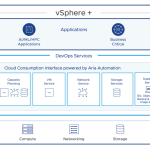Cloud-native applications are gaining mindshare, especially containerized apps that align well with the requirements of DevOps workflows, microservices, and immutable infrastructure trends. Developers and infrastructure experts must soon identify the platform for their next-generation workloads. Wouldn’t it be great if existing investments in skills, infrastructure, and technology ecosystem continued to offer the best environment to run all applications — including containerized apps?
Acknowledging that a single architecture may not satisfy the sometimes mutually exclusive requirements for traditional and third platform applications, VMware is gearing up for two new approaches in support of containerized apps.
Whether integrating with existing vSphere infrastructure to run alongside other workloads, or building an entirely new footprint optimized for high scale and churn, VMware has all of the bases covered!
vSphere Integrated Containers – Technology Preview
For those customers needing to support developers that are in the initial stages of deconstructing monolithic enterprise applications through microservices, Agile development, and DevOps workflows, the vSphere Integrated Containers (VIC) approach will serve them well.
VIC takes the basic constructs specified by the Open Container Initiative and maps them to the vSphere environment, exposing a virtual container host that is compatible with standard Docker client tools but backed by a flexible pool of resources to accommodate apps of many sizes. In this model, VMs essentially become containers and other aspects, such as storage and network, are mapped to corresponding elements of the vSphere platform. A tiny variant of Photon OS forms the basis of the container runtime in VIC. Performance and density is optimized through the use of Instant Clone – a feature of vSphere 6 that enables a running VM to be rapidly forked so that child VMs consume only resources that change from the parent base image.
Based on Project Bonneville technology, this is the most seamless way to provide a Docker container runtime environment with several advantages over bare-metal Linux container architectures. Hardware-level isolation of individual containers paves the way for capabilities in VIC that cannot be matched through a shared Linux kernel model.
Inherent benefits of the vSphere platform such as administrator tool choices — from the rich Web Client GUI to the productivity-boosting PowerCLI – are further extended by comprehensive application management and monitoring capabilities in vSphere and vRealize. These resource management features deliver enhanced abilities to meet enterprise SLAs for compute, network, and storage.
Photon Platform – Technology Preview
For those customers with new initiatives that have advanced cloud-native requirements, VMware is introducing the Photon Platform. The platform is a collection of technologies that provide infrastructure with just the features needed to securely run containerized applications, controlled by a massively-scalable distributed management plane with an API-first design approach. Photon Platform benefits from the solid heritage of the VMware ESXi hypervisor but favors scale and speed over the rich management features offered by vSphere.
Photon Platform consists of the following components:
- Photon Machine
- Secure ESX Microvisor based on the proven core of VMware ESXi and optimized for container-based workloads
- Photon OS – the lightweight Linux container runtime designed to integrate with VMware infrastructure
- Photon Controller
- Distributed management plane provides massive scale and resiliency
- API/CLI for flexible integration with DevOps workflows
Photon Platform will also provide an extensible provisioning capability that allows administrators to quickly instantiate popular consumptions surfaces for containerized applications such as Cloud Foundry, Kubernetes, or Mesos.
Scale, Speed, and Churn
For developers on the cutting edge of application architecture, a pattern is emerging that favors re-deployment over painstaking configuration management approaches often found in the traditional datacenter. This trend, sometimes called immutable infrastructure, forces deployments to be described programmatically and helps eliminate human bottlenecks and errors. Configuration changes can require many new VMs or containers to be deployed while old ones are rapidly destroyed, even further amplified when multiple development and test environments must also be delivered. These frequent deployments are automated, essentially eliminating the need for rich graphical interfaces and comprehensive wizards. Photon Platform foregoes full-featured centralized management tools, as they do not add the same value here that they do in traditional datacenter environments.
How to Choose
While VIC will quickly launch a container VM on demand, the magnitude would typically be in the tens, or possibly hundreds, at a time for an application. Photon Platform, on the other hand, is designed for environments where thousands or tens of thousands of containers are needed in a very short time – imagine how pleased your developers will be to learn that they can have a new Kubernetes endpoint with 1,000 nodes available for use within minutes — and another one a few minutes later!
Regardless of your cloud-native infrastructure needs, VMware will continue to be your trusted partner extending a strong record of innovation. Think of vSphere Integrated Containers as the enterprise-grade onramp to containerized applications, leveraging existing investments in technology and skillsets. Imagine Photon Platform as the next-generation infrastructure to support future initiatives that require incredible scale and churn for a range of popular container-centric consumption surfaces.
Both vSphere Integrated Containers and Photon Platform are currently Technology Previews. Please contact your VMware account team for more information or to learn about potential opportunities to participate in private betas.















